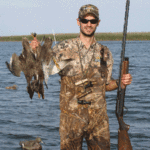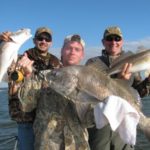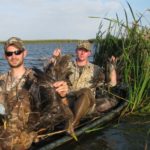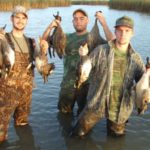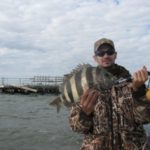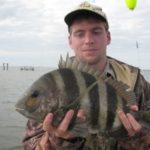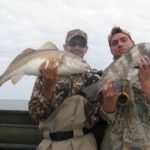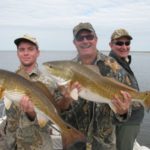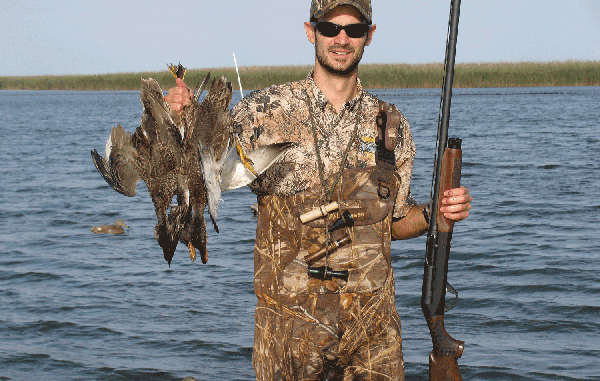
Don’t worry about river level this time of year: Just head down the Mississippi River for an some great duck hunting and a smorgasbord of fishing around East Bay’s shallow rigs.
After the stomping the Saints put on Detroit in the Dome, we were seriously pumped for the match in San Francisco the following week. For the occasion, Doc even installed an even wider screen TV in his Venice houseboat.
OK, so da Tigers had just gotten stomped by “Bama” for the championship. Like everyone else, we wailed and moaned and moped — but finally sucked it up. Because surely looming was another Saints Superbowl.
Football was the Venice weekend’s rationale — along with some duck hunting.
“So what’s with all da fishing poles?” Artie snorted at Pelayo, who was slipping them into the rod holders of his bay boat next to the decoy sack and two ’rogues. “Man ya gotta be outcha mind! Ain’t you heard? Da river came up, man — been up since right after Thanksgiving, as usual.”
“I know,” Pelayo huffed without even looking up. “But so what?”
“So there ain’t no more blasting and casting down here till maybe next August!” Artie laughed. “Da River, da diversion, da passes, da downriver spillways — it’s all chocolate milk right now. Look, (Artie pointed at the marina water a few feet from Pelayo) it’s even chocolate milk right here in da marina! Why y’all wasting your time fishing?
“Y’all get your ducks and hurry back for da game. We got that little hog Eddie shot last week in the smoker already. Smell it? Oughta be dynamite by kick-off time. Da keg’s already iced-down. Priscilla and the gals are bringing more wine. Man, last thing y’all want today is to get caught in da downriver fog and miss this evening’s paaaawtying!”
“We ain’t missing nothing,” the camo-clad Pelayo smirked back at Artie. “And the blastin and casting ain’t over for us. We’ll be back in time for the game, and with some duck breasts — maybe some big Canvasback ones — for your special cream- cheese/jalapeno-on-the-grill bit. But absolutely guaranteed are some thick drum, sheepshead and red fillets to sizzle alongside ’em. That little hog ain’t nearly enough for tonight’s crowd. The button-buck fajitas won’t last, either.
“So we’ll take up the slack with grilled fish. With a short little scoot into East Bay, it’s a slam dunk this time of year. And we’ll be hunting downriver in canvasback country, so hopefully we’ll blast a couple for your signature dish.”
How quickly we forget. Well, not really so quickly, more like a few decades. But back when Ernie “Da Wheel” Wheelright led the Saints in rushing and Walter “Da Flea” Roberts led in receptions — back in dat glorious age when By HEK and his buddy Dr. Royce Henry wanted to really load up on meat fish in late winter, they’d head for East Bay and hook up to the wells and rigs in shallow (12- to 20-foot) depths. Here they’d fill “box” after “box” with white trout, puppy drum, reds and sheepshead — and usually with nothing more elaborate than “maaaw-ket bait” on jigs or plain hooks.
Amazingly, these meat-hauls are still doable. Amazingly, catching and (most importantly!) showing off multiple “boxes” of fish is still possible (and perfectly legal) off Louisiana. White trout and sheepshead, after all, don’t have limits. Add the chunky puppy drum and reds that swarm around these shallow structures in winter, and there’s your “two- box” trip. For showing off, just layer the reds on top. A no-brainer!
Indeed, East Bay’s dozens of rigs and wells give you great old-time “rig-fishing” and “meat-fishing” with probably the shortest open-water ride along our coast.
The bottom drops off fast when you enter East Bay from Joseph’s Bayou. This after a short (relatively speaking) scoot down the river, a right at Southwest Pass, a left at Joseph’s Bayou — and another scoot to its mouth.
This also lets you fish fairly comfortably with up to 12-knot or so winds because you’re not really far from a lee shore. And up to the rig hook-up, you’ve been mostly in the protected river.
The route to East Bay takes you through the northwest corner of Pass-A-Loutre WMA. So naturally, we stopped in the little roseau and bullrush–enclosed ponds that dot this area for some late-morning “pothole duck hunting.” A higher tide would have seen us setting up in the more-open water of the mud and sand flats, with a better chance of getting some of those big, juicy canvasback breasts for Artie’s specialty.
We idled into a cut and promptly put up a few greys, mottled ducks and teal from behind some roseau. So we quickly zeroed in on their launching pads. We loaded up the ’rogues, paddled in and quickly noticed that a film of duckweed covered some of the roseau canes at the high-water mark. A few strands of milfoil and coontail were visible, sprouting from the muddy bottom, most of them stripped of their succulent leaves by the voracious puddle ducks we’d just spooked.
In minutes, Pelayo, Chris and I were standing amidst the roseau in our waders. As usual, the bottom was muddy in these (more or less) permanent ponds that don’t completely empty during low tides, making footing awkward. Hence our waders rather than the usual hip boots.
The ’rogues were jammed into the canes and bullrushes behind us, and Pelayo’s shiny white boat was also jammed into the canes and anchored in a 4-foot trennasse a couple hundred yards to our west.
Our “pond” might have spanned a hundred yards across, so we only bothered chunking out 10 dekes. This wasn’t like hunting the big, open bays and lagoons down here, where you’re often competing against hundreds of rafting ducks. This was almost like pothole or even flooded-timber hunting, with the roseau and a few crippled willows as the timber.
We started chuckling and whistling away — and in minutes Chris was pointing left at a flock of six.
“Greys,” hissed Pelayo.
Chances are they were among those we had recently put up. Their path would take them right over us. We hunkered down, and watched them close the distance through the cracks in our natural roseau blind. Their wings beat steadily. Their path was unwavering. None of that craning of the neck while looking around for company or a place to land. These knew where they were going — right where they’d been resting and munching minutes earlier.
The dekes danced on the end of their 6-foot lines. A crewboat roared down South Pass, and still they came. I caught movement, shifted my gaze and — WHAT?! Four teal were swimming in our dekes! They swooped in low and from our blind side. Typical for teal. Four teal by themselves would have been a superb bag for this impromptu “cast and blast.” But now we got greedy and nodded “no” to each while mouthing our calls.
We plastered our faces against the cane. Then uh-oh! At about a hundred yards, the lead grey started veering. He probably saw the boat, only 200 yards away. The other greys followed him. We mouthed the calls in desperation just as they swerved, and we saw the white of the underwings.
At Pelayo’s raspy hail, they slowed and seemed to swerve back on track. Chris and I chimed in with a few quacks and whistles, and Pelayo blasted out another hail — a short four-note one. They quickly reverted on track. On they came, but still high until at about a hundred yards they locked up for good and started dropping almost STRAIGHT down.
It was amazing. Cupped wings are one thing. These cupped their wings in almost to the body for a rapid descent. Usually you start calling at ducks at that altitude, and they’ll circle three or four times. Not these. This was their living room; they wanted back in. We could even watch the wind rustling their wing feathers, and what a heavenly sound. Here was another exciting feature of flooded timber hunting.
In seconds, they were almost on top of us. These had their wings spread wide, exposing their white bellies as they hovered over the farthest decoys. Big yellow feet started to dangle. My heart was in my throat as we rose to greet them at point-blank range.
Blaaaam! Our three shots went off almost as one. Naturally, all three of us aimed at the same two ducks, and they crumpled.
The others flapped off before we could recover our wits.
Much whooping and high-fiving, and then Chris started sloshing toward the ’rogue for a retrieve run. But Pelayo yanked him back by the arm. Another flock was heading straight for us. These were mottled ducks — big-bodied, with a deliberate wingbeat.
Again they were probably among those we spooked a bit earlier. We hunkered, turning our faces slightly to watch their approach. They passed about 80 yards to the left, and I gave a short (three-note) hail.
One cupped immediately, and started banking. The others flew on. I called again, and again. And after another hundred yards, the remaining trio decided to join the first.
They were well in range as we rose. BLAM! BLAM! BLAM! Two more “blacks” were in our bag — which finished out two hours later as three mottleds, three teal and three greys. Nothing close to limits, but we were jubilant and it was time to fish.
Bull croakers aren’t nearly as plentiful as they were along our coast 30 years ago, but they’re making a comeback around the shallower rigs (and jetties) near the mouth of the river. But what we knew would be stacked up were sheepshead, in their ravenous spawning mode.
By January they’re swarming around most rigs and wells in waters from 12- to 50-foot depths in East Bay, as they swarm around all such structures off the Louisiana coast in winter/early spring, when they can be hauled aboard practically at will on anything shrimp-tipped — even on the end of slaughter poles, as some commercial fisherfolk have lately learned.
Puppy drum and reds (these rigs are safely within state waters, so the reds go in “da box”) join the sheepshead in these murky waters surrounding these structures in winter.
But don’t let the surface water fool you. The murkiness is mostly on top, river water floating atop the salty Gulf waters. You often notice this in your prop wash, as the water churns up green.
We picked up the dekes hauled the ’rogues aboard and got on our fishing faces. In minutes we cleared the mouth of Joseph’s Bayou, and then followed the poles into the bay, grateful for a shallow-draft 21-foot boat, as this area silts up quickly and only the crewboats can keep up with the location of the deepest channel after the latest dredging.
We hooked up to a wellhead in 18-foot depths, perfect for evading those pesky red snapper and grouper so common in the deeper East Bay rigs, but whose size and number limits nowadays usually mean an exasperating marathon of catch-and-release (and later usually death) when fishing deeper water.
As expected, the water was murky on the surface, but — also as expected — the prop wash showed the saltier green water slightly underneath. Even better, the slack tide inside meant a slack current out here; hence our baits and jigs would stay close to the beams, where the fish tend to hang out, especially on the upcurrent side of the structure.
Our scuba diving trips have confirmed this time and again. Most fish tend to congregate on the upcurrent side of platforms and wells. We’ve seen it time and again.
Chris was frantic to get his bait in the water. He cast his shrimp-tipped 3/8-ounce jighead to the corner of the structure, and started letting out a little line. Pelayo followed suit, casting to the opposite corner.
I watched Chris reel in his slack, start “walking” the jig back along the bottom — then HAUL back as his medium spinning rod doubled over.
“Who-hoo!” he bellowed, while cranking away. “They’re HERE!” he whooped. “Don’t take long this time of year!”
“But of course!” Pelayo yelled from the bow, as he raised his bent rod overhead. “Did you ever doubt it! Ain’t many sure bets in fishing — but this kinda fishing, this time-a year is one!”
In short order I netted Chris’ red (about a 5-pounder) while Pelayo simply grabbed his 40-pound mono shock leader and swung his puppy drum aboard.
Finally, I dropped my shrimp-tipped jig — not to the bottom — but about 8 feet down next to a corner beam (kinda like jigging for sac-a-lait around cypress knees or downed trees). I flipped the bail, raised the rod tip a bit, lowered it, raised it again. Bump, bump came the telltale nibbles.
WHAM! I jerked up.
Sure enough. “They’re here!” I howled as my rod dipped, and I started cranking. “Gotta be a sheepshead!” He stripped off line in long, muscular back-and-forth lunges typical of his species.
And, sure enough, after a hearty battle that would shame any 6-pound speck, I swung aboard a 3-pound sheepshead.
For this frantic type of fishing, we like 30- to 40-pound mono shock leaders, about 3 feet long, atop the jigs so we can reach down and swing these babies in, one after another.
On my next cast, my shrimp-sweetened jig made it to the bottom and, seconds later, my rod was almost jerked from my hands.
“Looks like another red here!” I beamed. No nibbling for this guy.
“Yep, he’s streaking out for the open water,” yelled Chris. “Probably a borderline bull red.”
Mercifully, reds, drum and sheepshead tend to head away from the structure when hooked — in sharp contrast to the red and mangrove snapper that infest the deeper rigs in East Bay. When hooked, snapper instantly head for the beams to wrap your line, and all too often snap it or hopelessly snag it up.
Pelayo netted my red, and 45 five minutes later — after fishing a grand total of two structures — “da box” was half filled with the makings of chunky fillets for the grill.
We made it back to the houseboat well before dark, missing the excitement of a river run through the infamous Venice fog.
